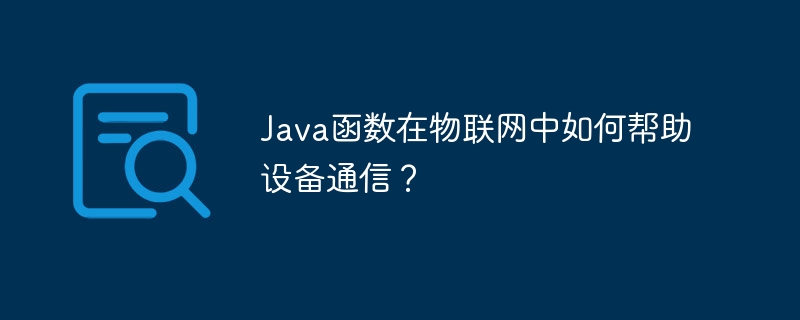Home >Java >javaTutorial >How do Java functions help devices communicate in the Internet of Things?
How do Java functions help devices communicate in the Internet of Things?
- WBOYWBOYWBOYWBOYWBOYWBOYWBOYWBOYWBOYWBOYWBOYWBOYWBOriginal
- 2024-04-28 10:45:01741browse
Java functions play a vital role in IoT device communication, enabling seamless communication between devices. They offer the following solutions: Standardization: Allows devices of different protocols and formats to communicate. Cloud deployment: ensuring high availability and scalability. Event-driven: Removes the burden of polling and connection management. Security: Execute in a sandbox environment and protected by the security measures of the cloud platform.

Java functions play a vital role in device communication in the Internet of Things
Java functions play a vital role in the Internet of Things (IoT) role to achieve seamless communication between devices. They provide powerful computing and connectivity capabilities that facilitate real-time data processing and device control. This article explores the use of Java functions in IoT device communication and provides a practical example to illustrate how it works.
Challenges of device communication
In the IoT environment, communication between devices faces the following challenges:
- Heterogeneous Responsibility: Devices may be from different vendors and use different protocols and data formats.
- Connectivity: The device may be in a mobile or limited connectivity environment, resulting in unstable communications.
- Security: Communications must be secure and reliable to prevent unauthorized access and data theft.
Solutions for Java Functions
Java Functions solve these challenges by:
- Standardization: They provide a common platform that allows devices of different protocols and formats to communicate.
- Cloud deployment: Functions can be deployed in the cloud to ensure high availability and scalability.
- Event-driven: Functions are triggered by events, such as message reception, which removes the burden of polling and connection management.
- Security: Functions are executed in a sandbox environment and are protected by the security measures of the cloud platform.
Practical Case: Sensor Data Processing
Consider a scenario where Java functions are used to process data from a sensor device. Here's how the function works:
- Create the function: Use the Cloud Functions API to create a function, specifying a trigger (for example, new sensor data) and processing logic.
- Write function code: Write function code in Java that parses sensor data into meaningful information.
- Deploy function: Deploy the function to a cloud platform, such as Google Cloud Functions.
- Send sensor data: The sensor device sends data to the function trigger through the MQTT protocol or other IoT protocols.
- Trigger function: The function is triggered by the incoming data and executes its processing logic.
- Processing data: Functions parse data, perform calculations, and generate responses as needed.
- Send a response (optional): If desired, the function can send a response via a predefined topic or queue.
Conclusion
By taking full advantage of the power and event-driven nature of Java functions, we can build reliable and scalable IoT device communication systems. They simplify interactions between heterogeneous devices, creating huge potential for IoT applications.
The above is the detailed content of How do Java functions help devices communicate in the Internet of Things?. For more information, please follow other related articles on the PHP Chinese website!

